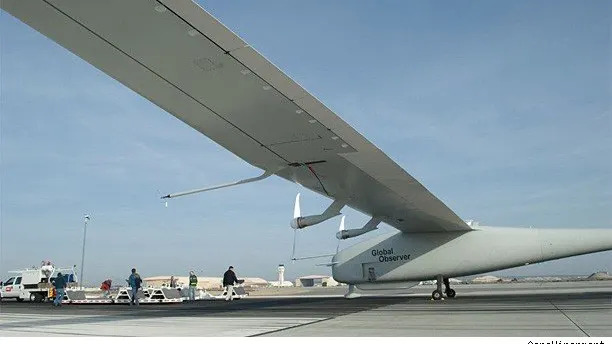
A new and promising "eye in the sky" inches closer to reality with successful testing of AeroVironment Inc.'s Global Observer high-altitude unmanned aircraft, designed to loiter above an area for up to a week at a time. On Oct. 26 the company said the 70-foot, propeller-driven aircraft, with a wingspan of 175 feet, had completed low-altitude airworthiness tests under battery power at Edwards Air Force Base in California. Over the next six months, the plane's actual powerplant will be used in further flight-testing. It's a liquid-hydrogen-fueled internal combustion engine driving a generator that produces electricity to turn the four props. We do live in the age of hybrids, after all.
If the U.S. government, which has spent $120 million for development, is satisfied and decides to deploy the first two all-composite aircraft, Global Observer could be in the sky in the next year or two. Eventually AeroVironment could build five an additional five aircraft a year.
Flying at 65,000 feet, the plane – depending on the contents of its 400-pound payload – can keep watch over a circle with a 600-mile diameter, tracking activity within about 280,000 square miles. Thus, the U.S. military could maintain continuous surveillance over most of Afghanistan, say, coordinating radio traffic or providing broadband coverage, among other tasks.
Satellites aren't always as useful to their earthling minders as they're cracked up to be. See, clouds and other obstacles can obscure the view. And stuff has a way of happening when non-geosynchronous satellites orbit out of range.
Disaster relief is another potential use. The plane could track and monitor a hurricane while coordinating evacuation planning and relief operations, according to the company. If cell towers, microwave relays and satellite downlinks are damaged, a Global Observer carrying a communications payload could take their place.
With Global Observer's eye above the Horn of Africa, Somali pirates could be identified for interception before they reach shipping lanes. Similarly, fires can be spotted early in large forests or national parks, or monitored on behalf of fire crews should they turn into large blazes. Border patrol is one more potential use, with sensing devices that can spot infiltrators. A single Global Observer could keep an eye on about a third of the border between the U.S. and Mexico.
AeroVironment, based in Monrovia, California, was founded by the late Dr. Paul MacCready, inventor of the human-powered Gossamer Albatross. The company has gained broad experience with small, human-launched pilotless drones now being used extensively by the U.S. military in the Middle East to scout and monitor enemy forces. Its other main product line is electric charging stations, residential and commercial, for battery-powered and plug-in hybrid vehicles like the Nissan Leaf. AeroVironment is also known for its role in creating the prototype for GM's EV1 electric car.
"Cost is just one benefit of operating Global Observer instead of a satellite," said Steve Gitlin, an AeroVironment vice president for marketing and public affairs. "With a satellite the payload is locked in. This plane can come down once a week and get a new payload."
Since a geosynchronous satellite must maintain a strict 22,500-mile distance from the earth, the Global Observer offers some obvious advantages by operating more than 2,000 times closer to the planet's surface.
And Aerovironment is proud of the fact that Global Observer neither emits nor uses any hydrocarbons.


Sign in to post
Please sign in to leave a comment.
Continue